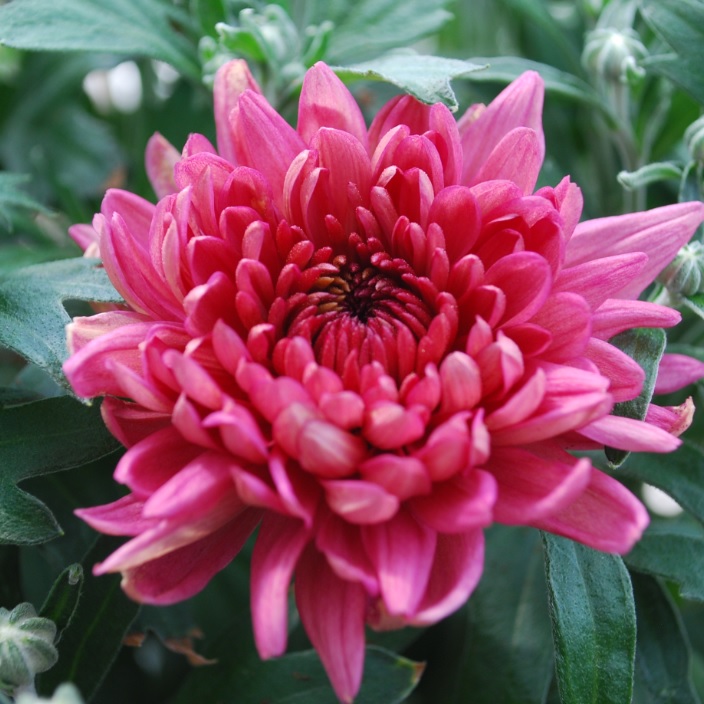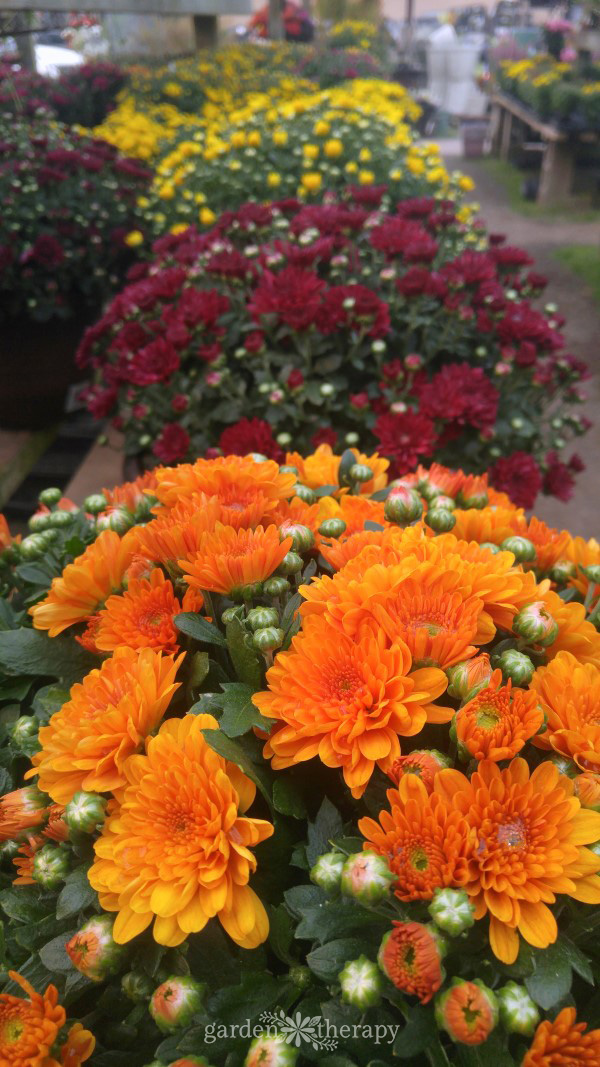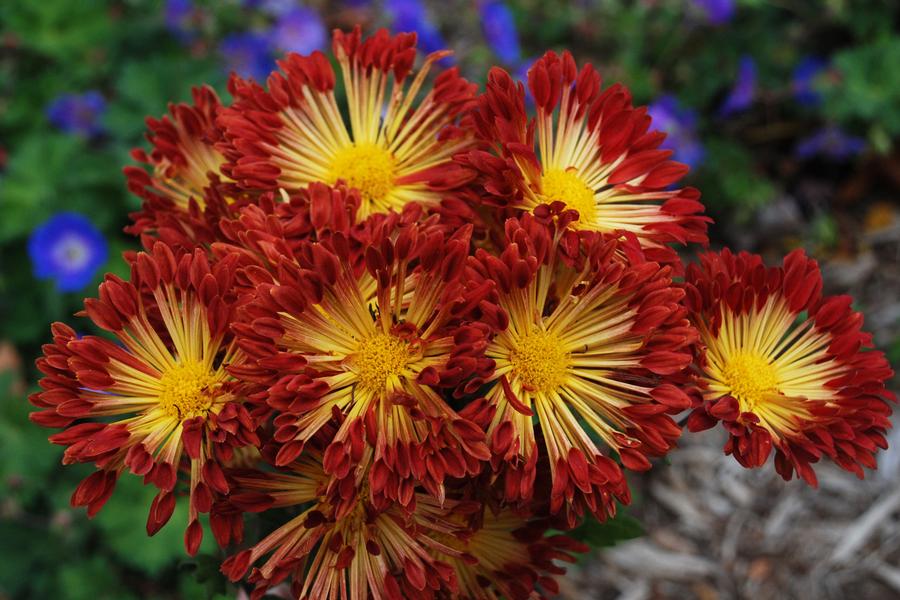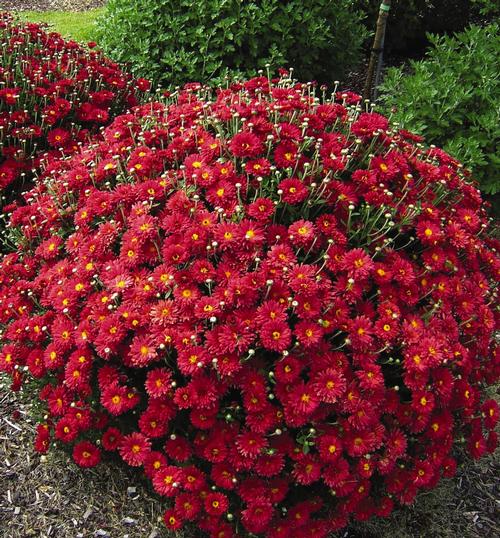Planting chrysanthemum in the spring gives the perennial plant time to establish and adapt to its new garden home. You'll easily find mums in garden centers and nurseries in both fall and spring, but planning ahead is key to successful planting. Planting in the spring will also result in a bigger bloom the following season. Although some fall mums can survive winter if planted immediately, the odds are much better with spring-planted mums. These fall landscaping flowers are sometimes planted as annuals but can be kept as a perennial plant with proper care.
Most garden mum plants are perennials through USDA plant hardiness zones 5-9. To prepare mums for winter, add a thick layer of 3 inches of mulch surrounding the root zone. Gorgeous mums in shades of red, yellow, orange, purple, and white pop up everywhere in the fall. I like to use them for autumn displays on my porch, along with dried cornstalks, gourds, and pumpkins.
But by the following spring, my plants are usually reduced to clumps of dead stems. After checking in with a few mum-growing pros, I realized I was planting my mums too late. In fact, garden mums are fairly easy to grow, once you know the following common mistakes to avoid.
The name "mum" is the shortened version of Chrysanthemum. From the basic yellow colors of mums, plant breeders and gardeners have produced mums with an array of colors and flower shapes. Mum plants come in white, yellow, gold, bronze, red, burgundy, pink, lavender, and purple.
Nature Hills markets mums that are basically called hardy mums. Hardy mums produces flowers after five to seven weeks of short days and thus they are often called fall mums. But if you plan to keep your mums as a perennial, plant seeds in the early spring or in the fall at least six weeks before your area's first hard freeze.
Hardy mums are fast-growing and will reach their full height within their first year, with the plant filling out a little more each subsequent year. Plant mums as soon as the soil warms in the spring. From late spring to mid-summer, pinch back the tips and flower buds on all shoots to make the plant bushier and prepare it for a dramatic fall show.
For optimal blooming, the plants should be fertilized regularly throughout the growing season. After the blooms fade, cut the plants down to about 6 inches, and cover them with straw or another dry mulch to protect the roots over winter. Established plants should be lifted and divided every two to three years. In general, the densely flowering mums that are offered for sale in full bloom in the fall should not be counted on to overwinter. You should find true winter hardy mums offered at garden centers alongside other hardy perennials, available throughout the planting season. Ideally, these should be planted in spring or summer to allow the roots a chance to establish before winter.
Amy Enfield, a horticulturist for Miracle-Gro, says garden mums should be planted outdoors by late summer or early fall, so the roots have time to form before the soil freezes. Also known as hardy or Belgian mums, garden mums are sold in garden centers and nurseries, and they're perennials in USDA Zones 5 to 9. But even when they're planted at the right time, they need a few other things, like excellent drainage. Enfield adds, "There's no guarantee they will survive the winter, particularly the further north you live in the U.S."
In contrast, some garden centers offer winter-hardy chrysanthemums that truly thrive in this region's landscapes year after year. Known as "Korean mums", these grow more shrub-like as they increase in size during the summer and fall. Most open their flowers no earlier than September and they obligingly endure cold weather and frosts, with many cultivars holding their color well into November. Fertilizing your mums gives them an added boost of essential nutrients for the best growth. The primary growth of chrysanthemum plant varieties takes place in spring and early summer.
If you plant fall mums, wait to begin their fertilization until the spring. Fall fertilization can actually reduce the hardiness of chrysanthemums to survive cold winters. If you live in a cold climate, it is best to leave the foliage on the plant, even after it has browned and died, to increase the plant's chance of surviving the winter.
In spring, you can prune out the dead leaves before the new ones start to develop. Mums aren't exactly "pruned," but are instead pinched throughout the growing season. This helps the plant branch out, become fuller and offer more blooms. When your plant reaches 6 inches tall in the spring, simply pinch off 1 inch of each shoot. Repeat this every 2 to 3 weeks until early summer.Deadhead spent blooms throughout the fall for an extended bloom time.
Once the plant has died in the winter, resist cutting it back. Research reveals that allowing it to die back naturally over the winter produces a stronger plant. Simply clean up the dead stems and foliage in the spring.
In moderate climates, that is hardiness zones 6 to 9, the most popular fall perennial is the garden chrysanthemum, often called cushion mum, fall mum, or garden mum. In colder climates, though, chrysanthemums haven't shown themselves to be particularly hardy and many gardeners have learned to treat them as annuals. Fortunately, there are now extra hardy garden mums to try, ones well adapted to climates as cold as zone 3. As their common name suggests, hardy mums are hardy both to cold and heat. They can handle temperatures up to 100 degrees Fahrenheit, though they'll need sufficient water and some shade in those conditions. Likewise, they can survive temperatures down to around 20 degrees Fahrenheit.
In cold climates just outside of their growing zones, they sometimes can survive winter if the roots are protected with a layer of mulch or straw. Leaving the degraded foliage in place over winter also can help to insulate the roots. A moderate humidity level is ideal for these plants. Finally, keep in mind that the fall mums sold in garden centers nowadays aren't the same kinds of plants sold 20 years ago, Enfield says. Although garden mums are considered hardy to Zone 5, breeders have developed fall mums with big mounds of showy flowers.
This has resulted, she says, in plants that may not be as cold hardy as in the past. So, if your fall-planted mums don't come back like true perennials, just treat them like annuals. Replace them with beautiful, fresh plants when you're ready to do your fall decorating and enjoy their colorful blooms for a season. However, there are varieties that are truly perennial in most climates when planted in the early spring or in the fall several weeks before the first frost. These plants grow fast, and you should have flowers in the first growing season. Bloom times vary with variety and climate from early September through mid-October.
It seems as soon as the air cools, signaling the coming of fall, garden centers begin showcasing full mounds of brilliant red, yellow, and violet flowers. Chrysanthemums, or mums, are a staple in fall gardens. Mums are a national symbol of fall abundance, and this herbaceous and hardy perennial is an easy addition to give a gorgeous pop of color in your fall garden landscape. With a little understanding and a few simple tips, you can have a lush, beautiful fall chrysanthemum garden display to help celebrate the changing of seasons. Garden mums (Chrysanthemum spp.) are herbaceous perennials in the daisy family and are stalwarts of the flowering autumn garden.
When garden centers sell blooming potted mums in the fall, they are usually used as annuals and discarded when the blooms fade. And when gardeners try to transplant these mums into the ground late in the season, chances are they won't make it through winter and become perennial. Many gardeners plant their hardy mums too late in the fall for them to overwinter successfully. This displacement is called frost heave or heaving. If hardy mums experience frost heave, roots can freeze , along with the plant crown or main growing point. While many of these Mum varieties are indeed hardy, they are unlikely to overwinter in our northern gardens.
This is because they are entering the winter in a weakened state. Growers pamper them in greenhouses throughout the season. In fall, when the plants are supposed to divert energy into root development to survive the upcoming winter, growers pump them with fertilizer to produce a profusion of flowers.
It can be tempting to plant mums closely together. Smaller, spring mums don't seem to fill out a garden space as well. However, keep in mind that by fall, most properly planted mums will reach up to 3 feet in height and width. Like many perennials, mums will often become larger each year. Even if your flower bed looks a bit bare when you first plant your mums, in time it will fill in.Spacing mums properly is essential for plant health. Plants that are too crowded compete for nutrients, have root system issues, attract pests and suffer from disease.
Following the plant spacing directions for your chrysanthemum variety increases the health of your garden and protects your investment of time and money. Flowering mums planted in the fall don't consistently make it through the winter. The plants don't have the time to extend their roots beyond the pot-bound root ball into the soil. The fragile roots are damaged by frequent cycles of freezing and thawing over the winter. Some growers have had success by wintering mums in a cool, dry location (garage, porch, etc.) that doesn't freeze.
After cutting off the foliage, keep these plants barely moist throughout the winter . Expose them to warmer temperatures and more water once the threat of frost is past. Many people are duped into buying mums during the fall months when the colorful potted flowers show up for sale in vibrant grocery and plant store displays.
But fall mums fare better when they're planted in the spring. Early planting makes it more likely that mums, which are generally perennials in USDA hardiness zones 5 through 9, will survive the winter. Purchasing locally-raised mums from a farm or nursery ensures that the varieties grown are well suited to your growing region. This is especially important if you will be transplanting the mum outdoors in your flower bed or displaying the potted plant outside.
Garden or hardy mums endure cooler outdoor temperatures better than florist mums, which are raised as indoor plants only. Many mums bloom throughout the fall months, but some species will provide blooms from late spring through the fall. In some cases, mum season varies according to the vagaries of the weather. There are perennial varieties, and if those are planted early enough, they can usually be counted on to last through the cold months and bloom for years to come.
This will stimulate the plant to produce new roots once you get it into the ground and thus massively increase its chances of survival. Even so, for the first year, you should cover the plant with a really thick mulch of shredded leaves or hay once the ground is frozen. Hardy mums prefer to grow in full sun, meaning at least six hours of direct sunlight on most days. However, in the warmer parts of their growing zones, they can benefit from some afternoon shade.
The flowers are photoperiodic, meaning they bloom in response to the shorter days and longer nights experienced in the late summer and fall. Therefore, don't plant them near street lights or night lights; the artificial lighting can wreak havoc with their cycle. If you want to avoid this hamster wheel of fall color hassle, consider planting perennial mums – winter hardy chrysanthemums – in the landscape beds instead.
Johnson's Nursery carries 5 of the Mammoth® Series , introduced by the University of Minnesota. Like most plants coming out of Minnesota, they are very cold tolerant and have a much better chance of surviving winter than their less expensive counterparts. Even better, they have been bred so you don't have to pinch them back during the summer for a bushy appearance. Nestle a pumpkin next to your perennial mums for the perfect harvest time landscape.
Perennial mums, on the other hand, should be planted directly into your garden bed in the spring. Though they sometimes have smaller flowers, they'll provide autumn color to your garden year after year. However, they do require more maintenance throughout the summer. Like annual mums, you'll get the best blooms if they're planted in full sun, but they will tolerate partial shade. This encourages them to grow fuller and bushier, and flower later into the season.
There would be few cut flowers blooming in October were it not for hardy garden mums. Their clusters of flowerheads show over a long period and are available in many colors, including red, orange, yellow, white, and lavender. The chrysanthemum growing rate depends on many variables. Different varieties feature different growth rates and mature size.
Plants grown from seed may take several years to reach their full growth potential. Mums grown from already-established garden center plants and division have a head-start on the growing season. Taking proper care of mums through watering, fertilizing and pinching increases the fullness and growth capabilities of the plant.
As perennials, mums are genetically programmed to lose their top growth to the frost, go to sleep for the winter, and wake up with the warm temperatures of the spring. When the foliage succumbs to frost, cut the plant back to the ground. Apply a thick layer of mulch (chopped leaves, pine needles, etc.) over the plants. When spring arrives and the threat of frost is over, pull back the mulch and watch your mums rapidly grow.



























No comments:
Post a Comment
Note: Only a member of this blog may post a comment.